The Cambridge History of China. Vol. 13: Republican China 1912-1949, Part 2
Подождите немного. Документ загружается.

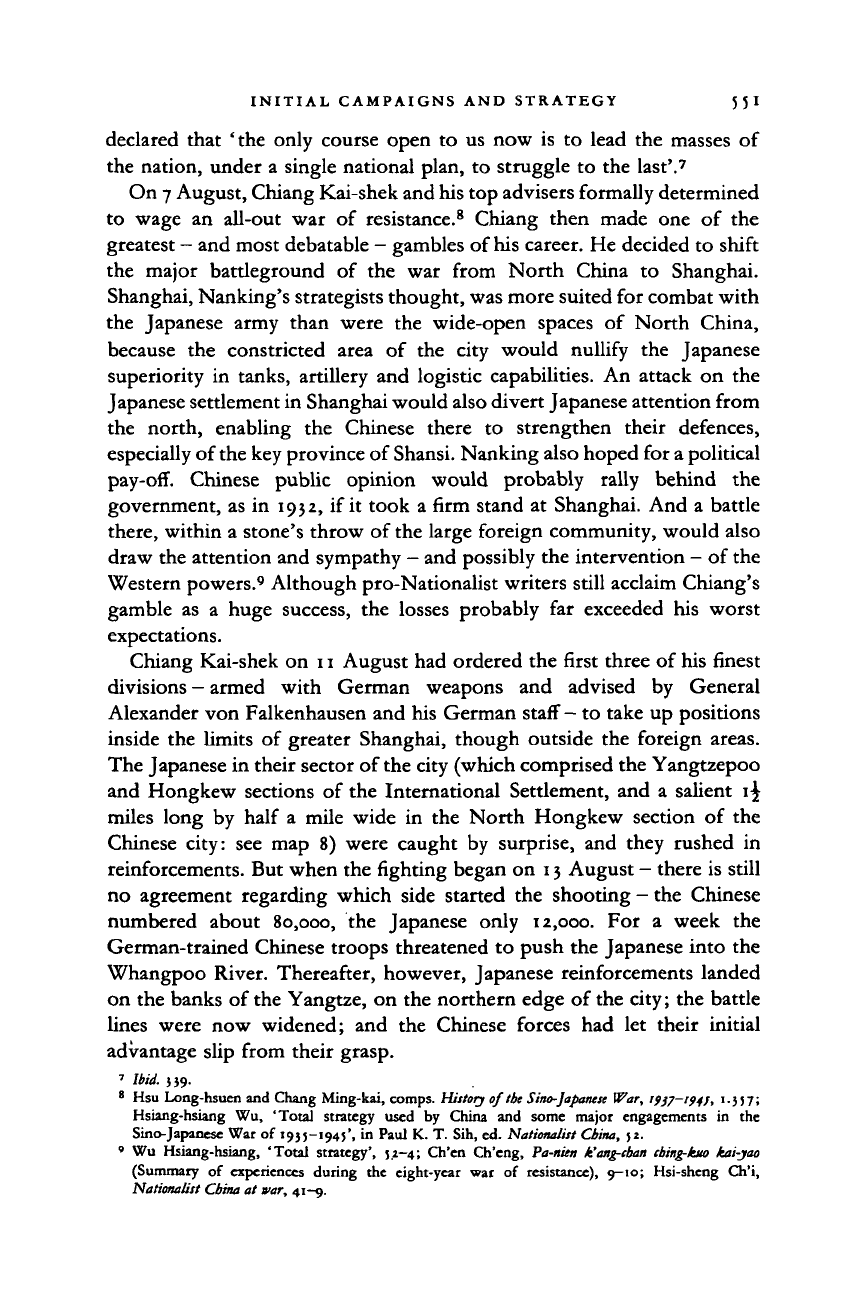
INITIAL CAMPAIGNS AND STRATEGY
5 5
I
declared that 'the only course open to us now is to lead the masses of
the nation, under a single national plan, to struggle to the last'.
7
On
7
August, Chiang Kai-shek and his top advisers formally determined
to wage an all-out war of resistance.
8
Chiang then made one of the
greatest - and most debatable - gambles of his career. He decided to shift
the major battleground of the war from North China to Shanghai.
Shanghai, Nanking's strategists thought, was more suited for combat with
the Japanese army than were the wide-open spaces of North China,
because the constricted area of the city would nullify the Japanese
superiority in tanks, artillery and logistic capabilities. An attack on the
Japanese settlement in Shanghai would also divert Japanese attention from
the north, enabling the Chinese there to strengthen their defences,
especially of the key province of
Shansi.
Nanking also hoped for a political
pay-off.
Chinese public opinion would probably rally behind the
government, as in 1932, if it took a firm stand at Shanghai. And a battle
there, within a stone's throw of the large foreign community, would also
draw the attention and sympathy - and possibly the intervention - of the
Western powers.
9
Although pro-Nationalist writers still acclaim Chiang's
gamble as a huge success, the losses probably far exceeded his worst
expectations.
Chiang Kai-shek on 11 August had ordered the first three of his finest
divisions - armed with German weapons and advised by General
Alexander von Falkenhausen and his German staff - to take up positions
inside the limits of greater Shanghai, though outside the foreign areas.
The Japanese in their sector of the city (which comprised the Yangtzepoo
and Hongkew sections of the International Settlement, and a salient 1^
miles long by half a mile wide in the North Hongkew section of the
Chinese city: see map 8) were caught by surprise, and they rushed in
reinforcements. But when the fighting began on 13 August - there is still
no agreement regarding which side started the shooting - the Chinese
numbered about 80,000, the Japanese only 12,000. For a week the
German-trained Chinese troops threatened to push the Japanese into the
Whangpoo River. Thereafter, however, Japanese reinforcements landed
on the banks of the Yangtze, on the northern edge of the city; the battle
lines were now widened; and the Chinese forces had let their initial
advantage slip from their grasp.
7
Ibid.
339.
8
Hsu Long-hsuen and Chang Ming-kai, comps. History of the Sino-japantse War, 1937-194!, 1.357;
Hsiang-hsiang Wu, 'Total strategy used by China and some major engagements in the
Sino-Japanese War of 1935-1945', in Paul K. T. Sih, ed. Nationalist China, 52.
' Wu Hsiang-hsiang, 'Total strategy', 5,2-4; Ch'en Ch'eng, Pa-nien k'ang-cban cbing-kuo kai-jao
(Summary of experiences during the eight-year war of resistance), 9—10; Hsi-sheng Ch'i,
Nationalist China at war, 41—9.
Cambridge Histories Online © Cambridge University Press, 2008
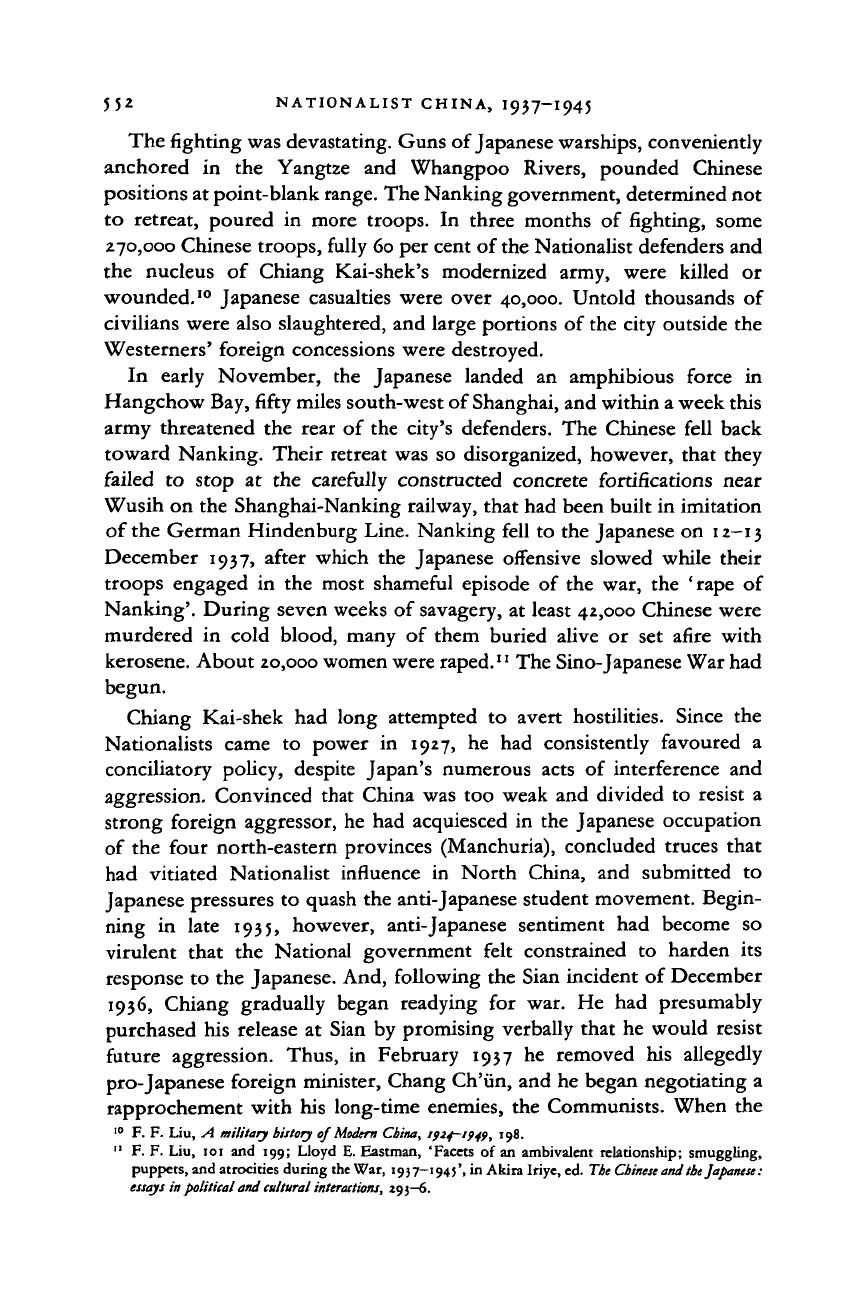
552 NATIONALIST CHINA, 1957-1945
The fighting was devastating. Guns of Japanese warships, conveniently
anchored in the Yangtze and Whangpoo Rivers, pounded Chinese
positions at point-blank range. The Nanking government, determined not
to retreat, poured in more troops. In three months of fighting, some
270,000 Chinese troops, fully 60 per cent of the Nationalist defenders and
the nucleus of Chiang Kai-shek's modernized army, were killed or
wounded.
10
Japanese casualties were over 40,000. Untold thousands of
civilians were also slaughtered, and large portions of the city outside the
Westerners' foreign concessions were destroyed.
In early November, the Japanese landed an amphibious force in
Hangchow Bay, fifty miles south-west of Shanghai, and within a week this
army threatened the rear of the city's defenders. The Chinese fell back
toward Nanking. Their retreat was so disorganized, however, that they
failed to stop at the carefully constructed concrete fortifications near
Wusih on the Shanghai-Nanking railway, that had been built in imitation
of the German Hindenburg Line. Nanking fell to the Japanese on 12-13
December 1937, after which the Japanese offensive slowed while their
troops engaged in the most shameful episode of the war, the 'rape of
Nanking'. During seven weeks of savagery, at least 42,000 Chinese were
murdered in cold blood, many of them buried alive or set afire with
kerosene. About 20,000 women were raped.'' The Sino-Japanese War had
begun.
Chiang Kai-shek had long attempted to avert hostilities. Since the
Nationalists came to power in 1927, he had consistently favoured a
conciliatory policy, despite Japan's numerous acts of interference and
aggression. Convinced that China was too weak and divided to resist a
strong foreign aggressor, he had acquiesced in the Japanese occupation
of the four north-eastern provinces (Manchuria), concluded truces that
had vitiated Nationalist influence in North China, and submitted to
Japanese pressures to quash the anti-Japanese student movement. Begin-
ning in late 1935, however, anti-Japanese sentiment had become so
virulent that the National government felt constrained to harden its
response to the Japanese. And, following the Sian incident of December
1936,
Chiang gradually began readying for war. He had presumably
purchased his release at Sian by promising verbally that he would resist
future aggression. Thus, in February 1937 he removed his allegedly
pro-Japanese foreign minister, Chang Ch'iin, and he began negotiating a
rapprochement with his long-time enemies, the Communists. When the
10
F. F. Liu, A military history of
Modern
China, 1914-1949, 198.
11
F. F. Liu, 101 and 199; Lloyd E. Eastman, 'Facets of an ambivalent relationship; smuggling,
puppets, and atrocities during the War, 1937-1945', in Akira Iriye, ed. The
Chinese
andthe Japanese:
essays in political and cultural
interactions,
293—6.
Cambridge Histories Online © Cambridge University Press, 2008
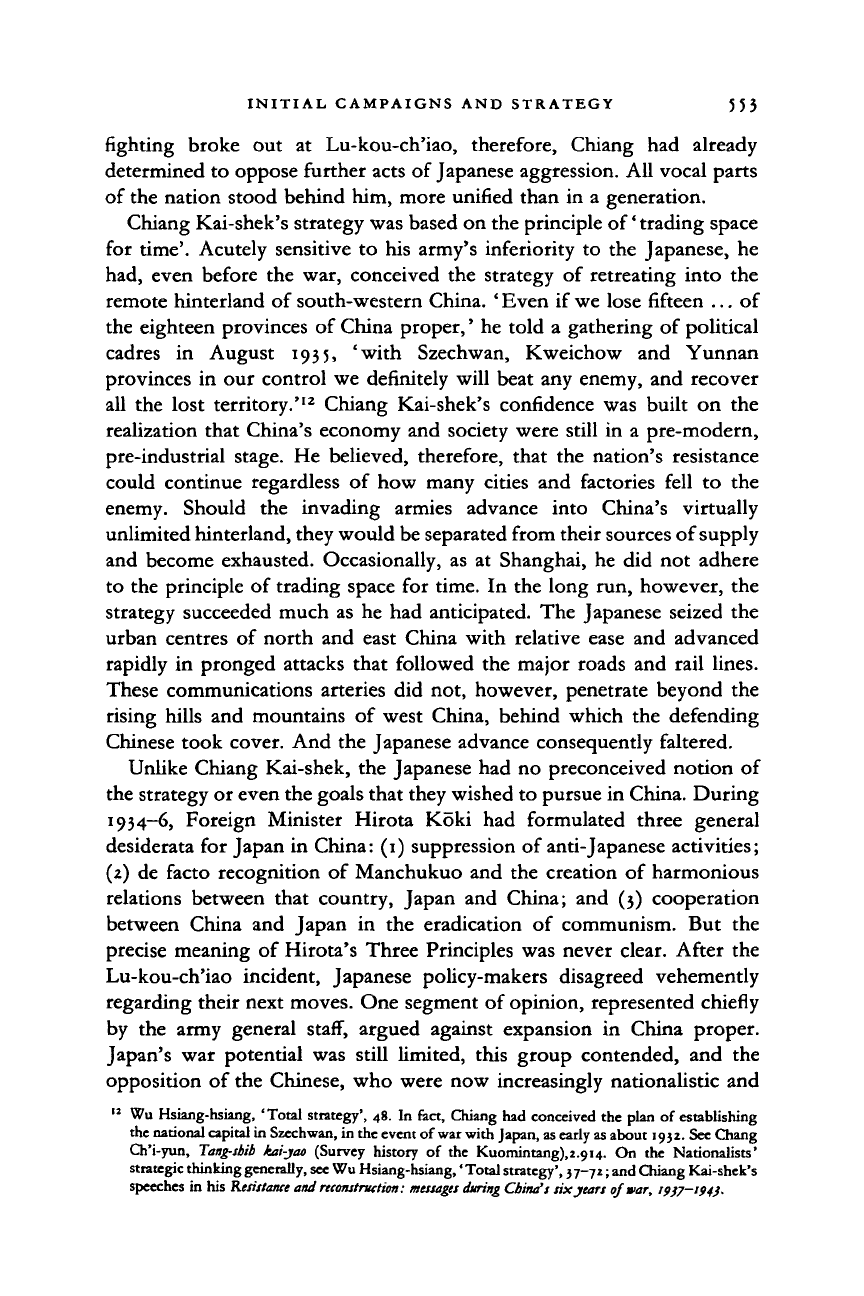
INITIAL CAMPAIGNS AND STRATEGY 553
fighting broke out at Lu-kou-ch'iao, therefore, Chiang had already
determined to oppose further acts of Japanese aggression. All vocal parts
of the nation stood behind him, more unified than in a generation.
Chiang Kai-shek's strategy was based on the principle of' trading space
for time'. Acutely sensitive to his army's inferiority to the Japanese, he
had, even before the war, conceived the strategy of retreating into the
remote hinterland of south-western China. ' Even if we lose fifteen ... of
the eighteen provinces of China proper,' he told a gathering of political
cadres in August 1935, 'with Szechwan, Kweichow and Yunnan
provinces in our control we definitely will beat any enemy, and recover
all the lost territory.'
12
Chiang Kai-shek's confidence was built on the
realization that China's economy and society were still in a pre-modern,
pre-industrial stage. He believed, therefore, that the nation's resistance
could continue regardless of how many cities and factories fell to the
enemy. Should the invading armies advance into China's virtually
unlimited hinterland, they would be separated from their sources of supply
and become exhausted. Occasionally, as at Shanghai, he did not adhere
to the principle of trading space for time. In the long run, however, the
strategy succeeded much as he had anticipated. The Japanese seized the
urban centres of north and east China with relative ease and advanced
rapidly in pronged attacks that followed the major roads and rail lines.
These communications arteries did not, however, penetrate beyond the
rising hills and mountains of west China, behind which the defending
Chinese took cover. And the Japanese advance consequently faltered.
Unlike Chiang Kai-shek, the Japanese had no preconceived notion of
the strategy or even the goals that they wished to pursue in China. During
1934-6,
Foreign Minister Hirota Koki had formulated three general
desiderata for Japan in China: (1) suppression of anti-Japanese activities;
(2) de facto recognition of Manchukuo and the creation of harmonious
relations between that country, Japan and China; and (3) cooperation
between China and Japan in the eradication of communism. But the
precise meaning of Hirota's Three Principles was never clear. After the
Lu-kou-ch'iao incident, Japanese policy-makers disagreed vehemently
regarding their next moves. One segment of opinion, represented chiefly
by the army general
staff,
argued against expansion in China proper.
Japan's war potential was still limited, this group contended, and the
opposition of the Chinese, who were now increasingly nationalistic and
12
Wu Hsiang-hsiang, 'Total strategy', 48. In feet, Chiang had conceived the plan of establishing
the national capital in Szechwan, in the event of
war
with Japan,
as
early
as
about 1932. See Chang
Ch'i-yun, Tangsbib kai-jao (Survey history of the Kuomintang),2.9i4. On the Nationalists'
strategic thinking generally, see
Wu
Hsiang-hsiang,' Total strategy',
37-72;
and Chiang Kai-shek's
speeches in his Resistance and rtcorutruction:
messages
during China't six years of war, 19)7-194).
Cambridge Histories Online © Cambridge University Press, 2008
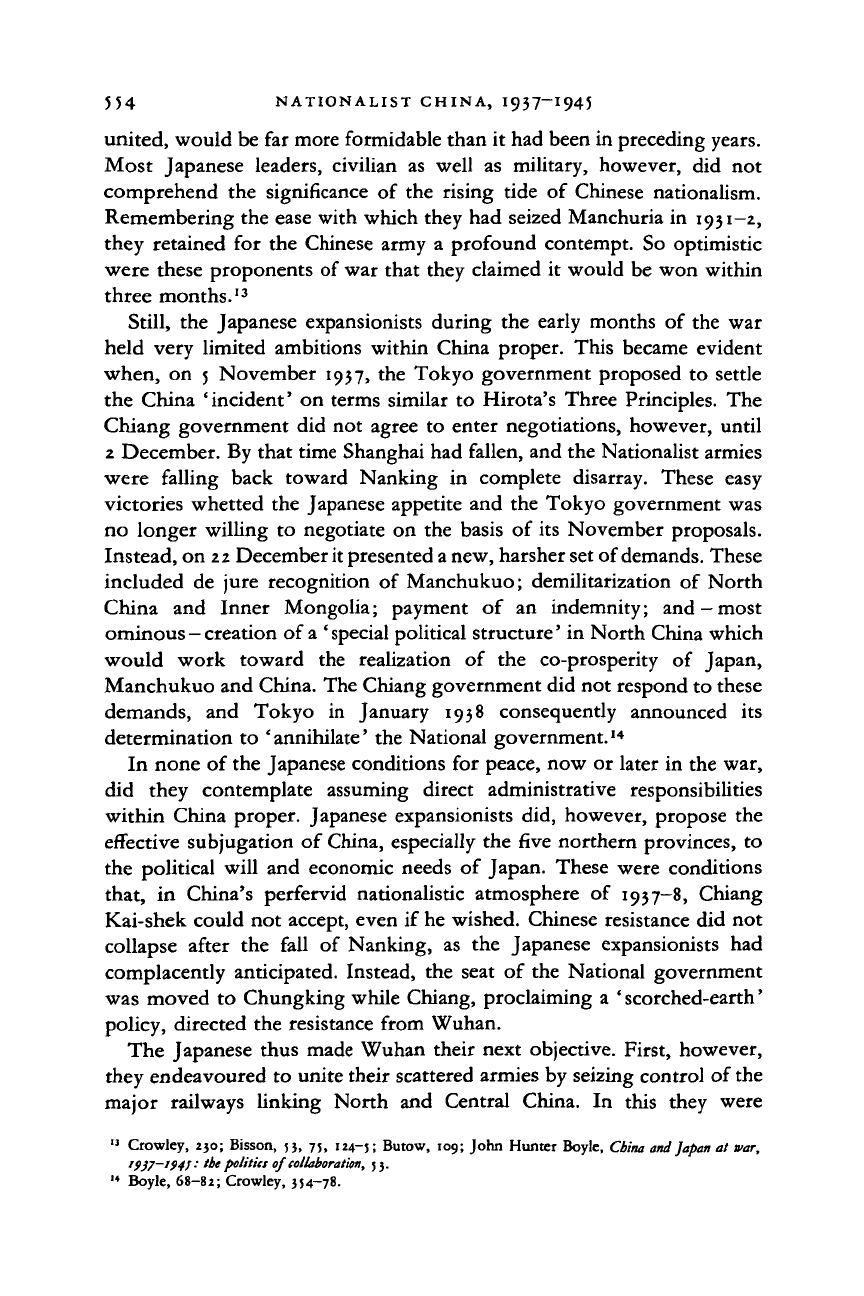
554 NATIONALIST CHINA, 1937-1945
united, would be far more formidable than it had been in preceding years.
Most Japanese leaders, civilian as well as military, however, did not
comprehend the significance of the rising tide of Chinese nationalism.
Remembering the ease with which they had seized Manchuria in 1931—2,
they retained for the Chinese army a profound contempt. So optimistic
were these proponents of war that they claimed it would be won within
three months.
13
Still, the Japanese expansionists during the early months of the war
held very limited ambitions within China proper. This became evident
when, on 5 November 1937, the Tokyo government proposed to settle
the China 'incident' on terms similar to Hirota's Three Principles. The
Chiang government did not agree to enter negotiations, however, until
2 December. By that time Shanghai had fallen, and the Nationalist armies
were falling back toward Nanking in complete disarray. These easy
victories whetted the Japanese appetite and the Tokyo government was
no longer willing to negotiate on the basis of its November proposals.
Instead, on 22 December it presented a new, harsher set of demands. These
included de jure recognition of Manchukuo; demilitarization of North
China and Inner Mongolia; payment of an indemnity; and
—
most
ominous - creation of a ' special political structure' in North China which
would work toward the realization of the co-prosperity of Japan,
Manchukuo and China. The Chiang government did not respond to these
demands, and Tokyo in January 1938 consequently announced its
determination to 'annihilate' the National government.
14
In none of the Japanese conditions for peace, now or later in the war,
did they contemplate assuming direct administrative responsibilities
within China proper. Japanese expansionists did, however, propose the
effective subjugation of China, especially the five northern provinces, to
the political will and economic needs of Japan. These were conditions
that, in China's perfervid nationalistic atmosphere of 1937-8, Chiang
Kai-shek could not accept, even if he wished. Chinese resistance did not
collapse after the fall of Nanking, as the Japanese expansionists had
complacently anticipated. Instead, the seat of the National government
was moved to Chungking while Chiang, proclaiming a ' scorched-earth'
policy, directed the resistance from Wuhan.
The Japanese thus made Wuhan their next objective. First, however,
they endeavoured to unite their scattered armies by seizing control of the
major railways linking North and Central China. In this they were
13
Crowley, 230; Bisson, 53, 75, 124-5; Butow, 109; John Hunter Boyle, China and Japan at war,
19)7-194}: the politics of
collaboration,
5
3.
14
Boyle, 68-82; Crowley, 354—78.
Cambridge Histories Online © Cambridge University Press, 2008
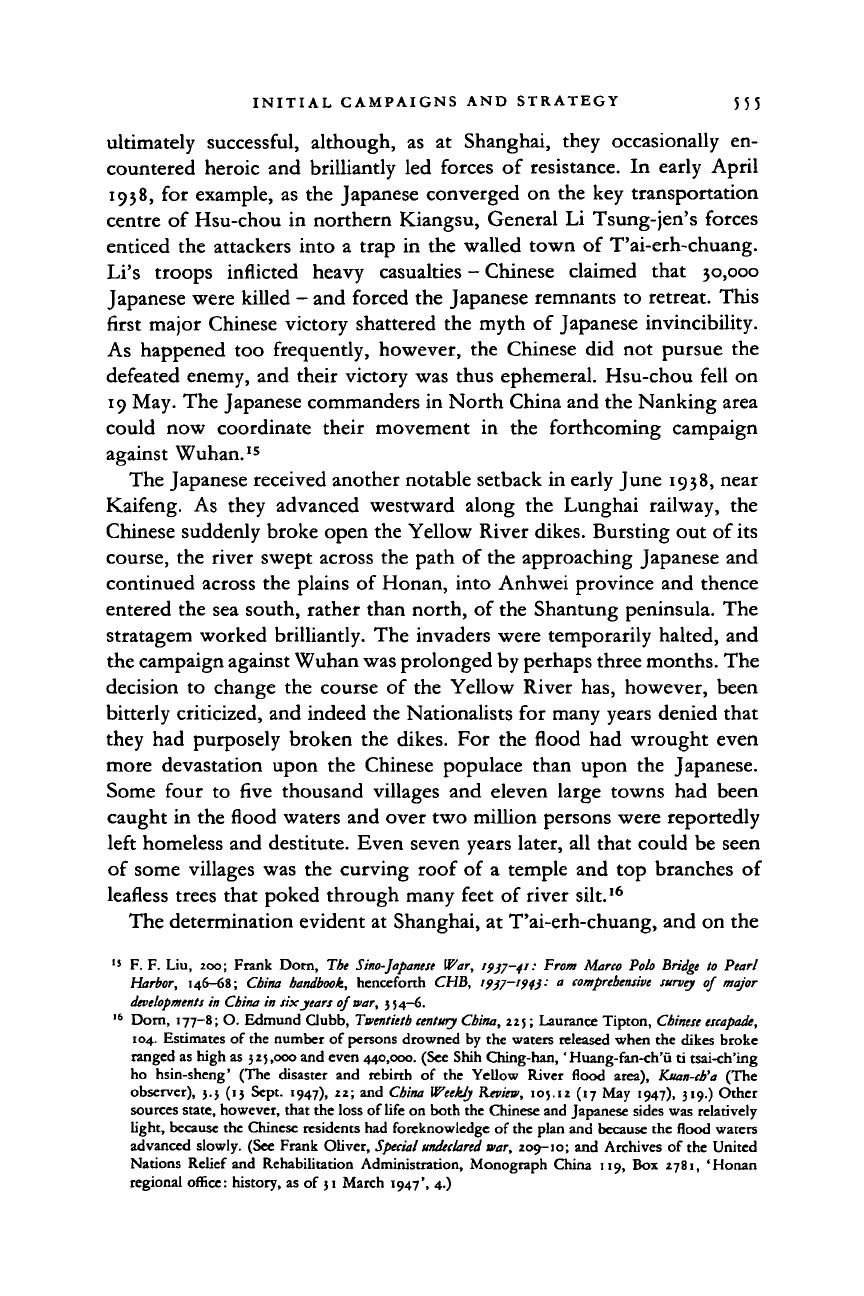
INITIAL CAMPAIGNS AND STRATEGY 555
ultimately successful, although, as at Shanghai, they occasionally en-
countered heroic and brilliantly led forces of resistance. In early April
1938,
for example, as the Japanese converged on the key transportation
centre of Hsu-chou in northern Kiangsu, General Li Tsung-jen's forces
enticed the attackers into a trap in the walled town of T'ai-erh-chuang.
Li's troops inflicted heavy casualties - Chinese claimed that 30,000
Japanese were killed - and forced the Japanese remnants to retreat. This
first major Chinese victory shattered the myth of Japanese invincibility.
As happened too frequently, however, the Chinese did not pursue the
defeated enemy, and their victory was thus ephemeral. Hsu-chou fell on
19 May. The Japanese commanders in North China and the Nanking area
could now coordinate their movement in the forthcoming campaign
against Wuhan.
15
The Japanese received another notable setback in early June 1938, near
Kaifeng. As they advanced westward along the Lunghai railway, the
Chinese suddenly broke open the Yellow River dikes. Bursting out of its
course, the river swept across the path of the approaching Japanese and
continued across the plains of Honan, into Anhwei province and thence
entered the sea south, rather than north, of the Shantung peninsula. The
stratagem worked brilliantly. The invaders were temporarily halted, and
the campaign against Wuhan was prolonged by perhaps three months. The
decision to change the course of the Yellow River has, however, been
bitterly criticized, and indeed the Nationalists for many years denied that
they had purposely broken the dikes. For the flood had wrought even
more devastation upon the Chinese populace than upon the Japanese.
Some four to five thousand villages and eleven large towns had been
caught in the flood waters and over two million persons were reportedly
left homeless and destitute. Even seven years later, all that could be seen
of some villages was the curving roof of a temple and top branches of
leafless trees that poked through many feet of river silt.
16
The determination evident at Shanghai, at T'ai-erh-chuang, and on the
" F. F. Liu, 200; Frank Dom, The Sino-Japanese War, 1937-41: From Marco Polo Bridge to Pearl
Harbor, 146-68; China handbook, henceforth CHB, 19)7-194): a
comprehensive
survey of major
developments
in China in six years of war, 354-6.
16
Dorn, 177-8; O. Edmund Clubb, Twentieth
century
China, 225; Laurance Tipton, Chinese
escapade,
104.
Estimates of the number of persons drowned by the waters released when the dikes broke
ranged as high as 325,000 and even 440,000. (See Shih Ching-han,'Huang-fan-ch'u ti tsai-ch'ing
ho hsin-sheng' (The disaster and rebirth of the Yellow River flood area), Kuan-cb'a (The
observer), 3.3 (13 Sept. 1947), 22; and China Weekly Review, 105.12 (17 May 1947), 319.) Other
sources state, however, that the loss of life on both the Chinese and Japanese sides was relatively
light, because the Chinese residents had foreknowledge of the plan and because the flood waters
advanced slowly. (See Frank Oliver, Special
undeclared
mar, 209—10; and Archives of the United
Nations Relief and Rehabilitation Administration, Monograph China 119, Box 2781, 'Honan
regional office: history, as of 31 March 1947', 4.)
Cambridge Histories Online © Cambridge University Press, 2008
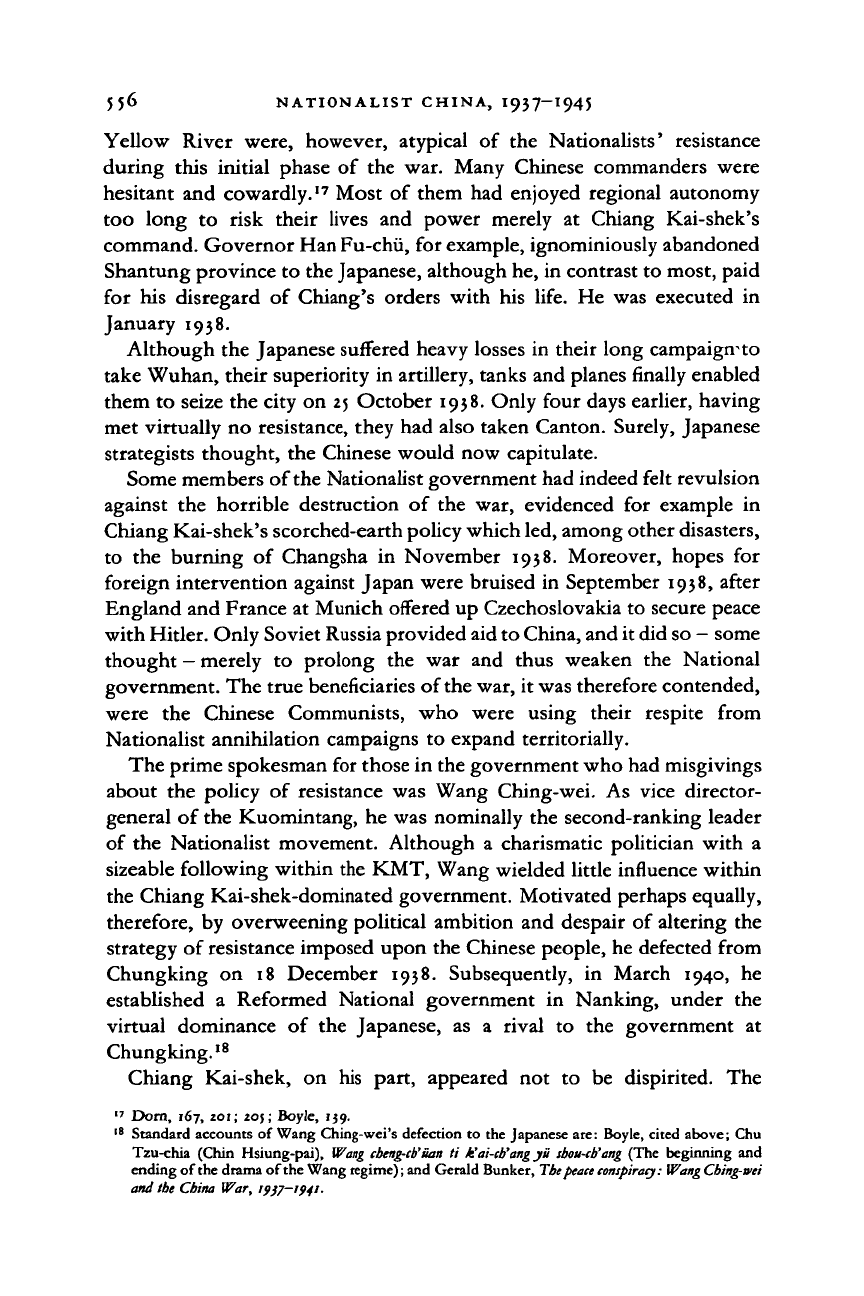
55^
NATIONALIST CHINA, I937
-I
945
Yellow River were, however, atypical
of
the Nationalists' resistance
during this initial phase
of
the war. Many Chinese commanders were
hesitant and cowardly.
17
Most
of
them had enjoyed regional autonomy
too long
to
risk their lives
and
power merely
at
Chiang Kai-shek's
command. Governor Han Fu-chii, for example, ignominiously abandoned
Shantung province to the Japanese, although he, in contrast to most, paid
for his disregard
of
Chiang's orders with his life. He was executed
in
January 1938.
Although the Japanese suffered heavy losses in their long campaigns
take Wuhan, their superiority in artillery, tanks and planes finally enabled
them to seize the city on
25
October 1938. Only four days earlier, having
met virtually no resistance, they had also taken Canton. Surely, Japanese
strategists thought, the Chinese would now capitulate.
Some members of the Nationalist government had indeed felt revulsion
against
the
horrible destruction
of
the war, evidenced
for
example
in
Chiang Kai-shek's scorched-earth policy which led, among other disasters,
to
the
burning
of
Changsha
in
November 1938. Moreover, hopes
for
foreign intervention against Japan were bruised in September 1938, after
England and France at Munich offered up Czechoslovakia to secure peace
with Hitler. Only Soviet Russia provided aid to China, and it did so
-
some
thought
—
merely
to
prolong
the war and
thus weaken
the
National
government. The true beneficiaries of the war, it was therefore contended,
were
the
Chinese Communists,
who
were using their respite from
Nationalist annihilation campaigns to expand territorially.
The prime spokesman for those in the government who had misgivings
about the policy
of
resistance was Wang Ching-wei.
As
vice director-
general of the Kuomintang, he was nominally the second-ranking leader
of the Nationalist movement. Although
a
charismatic politician with
a
sizeable following within the KMT, Wang wielded little influence within
the Chiang Kai-shek-dominated government. Motivated perhaps equally,
therefore, by overweening political ambition and despair
of
altering the
strategy of resistance imposed upon the Chinese people, he defected from
Chungking
on 18
December 1938. Subsequently,
in
March 1940,
he
established
a
Reformed National government
in
Nanking, under
the
virtual dominance
of
the Japanese,
as a
rival
to the
government
at
Chungking.
18
Chiang Kai-shek,
on his
part, appeared
not to be
dispirited.
The
17
Dorn, 167, 201; 205; Boyle, 139.
18
Standard accounts of Wang Ching-wei's defection to the Japanese ate: Boyle, cited above; Chu
Tzu-chia (Chin Hsiung-pai),
Wang cheng-cb'iian
ti
k'ai-cb'angju
sbou-cb'ang
(The beginning and
ending of the drama of the Wang
regime);
and Gerald Bunker,
Tbeptace
conspiracy:
Wang Cbing-wti
and the China
War, 1)37-1941.
Cambridge Histories Online © Cambridge University Press, 2008
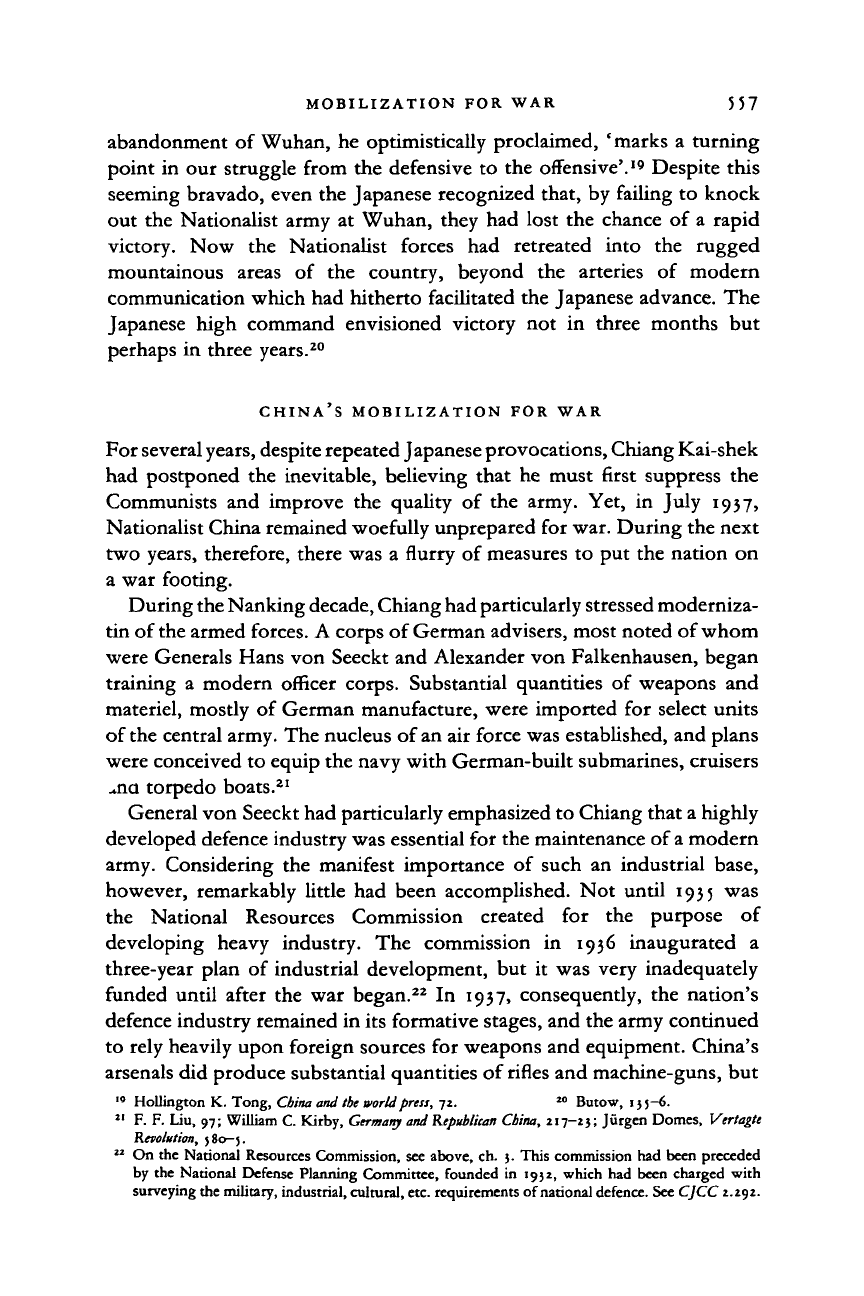
MOBILIZATION FOR WAR 557
abandonment of Wuhan, he optimistically proclaimed, 'marks a turning
point in our struggle from the defensive to the offensive'.
19
Despite this
seeming bravado, even the Japanese recognized that, by failing to knock
out the Nationalist army at Wuhan, they had lost the chance of a rapid
victory. Now the Nationalist forces had retreated into the rugged
mountainous areas of the country, beyond the arteries of modern
communication which had hitherto facilitated the Japanese advance. The
Japanese high command envisioned victory not in three months but
perhaps in three years.
20
CHINA'S MOBILIZATION FOR WAR
For several
years,
despite repeated Japanese provocations, Chiang Kai-shek
had postponed the inevitable, believing that he must first suppress the
Communists and improve the quality of the army. Yet, in July 1937,
Nationalist China remained woefully unprepared for war. During the next
two years, therefore, there was a flurry of measures to put the nation on
a war footing.
During the Nanking
decade,
Chiang had particularly stressed moderniza-
tin of the armed forces. A corps of German advisers, most noted of whom
were Generals Hans von Seeckt and Alexander von Falkenhausen, began
training a modern officer corps. Substantial quantities of weapons and
materiel, mostly of German manufacture, were imported for select units
of the central army. The nucleus of an air force was established, and plans
were conceived to equip the navy with German-built submarines, cruisers
..nd torpedo boats.
21
General von Seeckt had particularly emphasized to Chiang that a highly
developed defence industry was essential for the maintenance of
a
modern
army. Considering the manifest importance of such an industrial base,
however, remarkably little had been accomplished. Not until 1935 was
the National Resources Commission created for the purpose of
developing heavy industry. The commission in 1936 inaugurated a
three-year plan of industrial development, but it was very inadequately
funded until after the war began.
22
In 1937, consequently, the nation's
defence industry remained in its formative stages, and the army continued
to rely heavily upon foreign sources for weapons and equipment. China's
arsenals did produce substantial quantities of rifles and machine-guns, but
" Hollington K. Tong, China and the world press, 72.
M
Butow,
13
5—6.
11
F. F. Liu, 97; William C. Kirby, Germany and Republican China, 217-23; Jurgen Domes, Vertagte
Revolution, 580-5.
22
On the National Resources Commission, see above, ch. 3. This commission had been preceded
by the National Defense Planning Committee, founded in 1932, which had been charged with
surveying the military, industrial, cultural, etc. requirements of national defence. See CJCC 2.292.
Cambridge Histories Online © Cambridge University Press, 2008
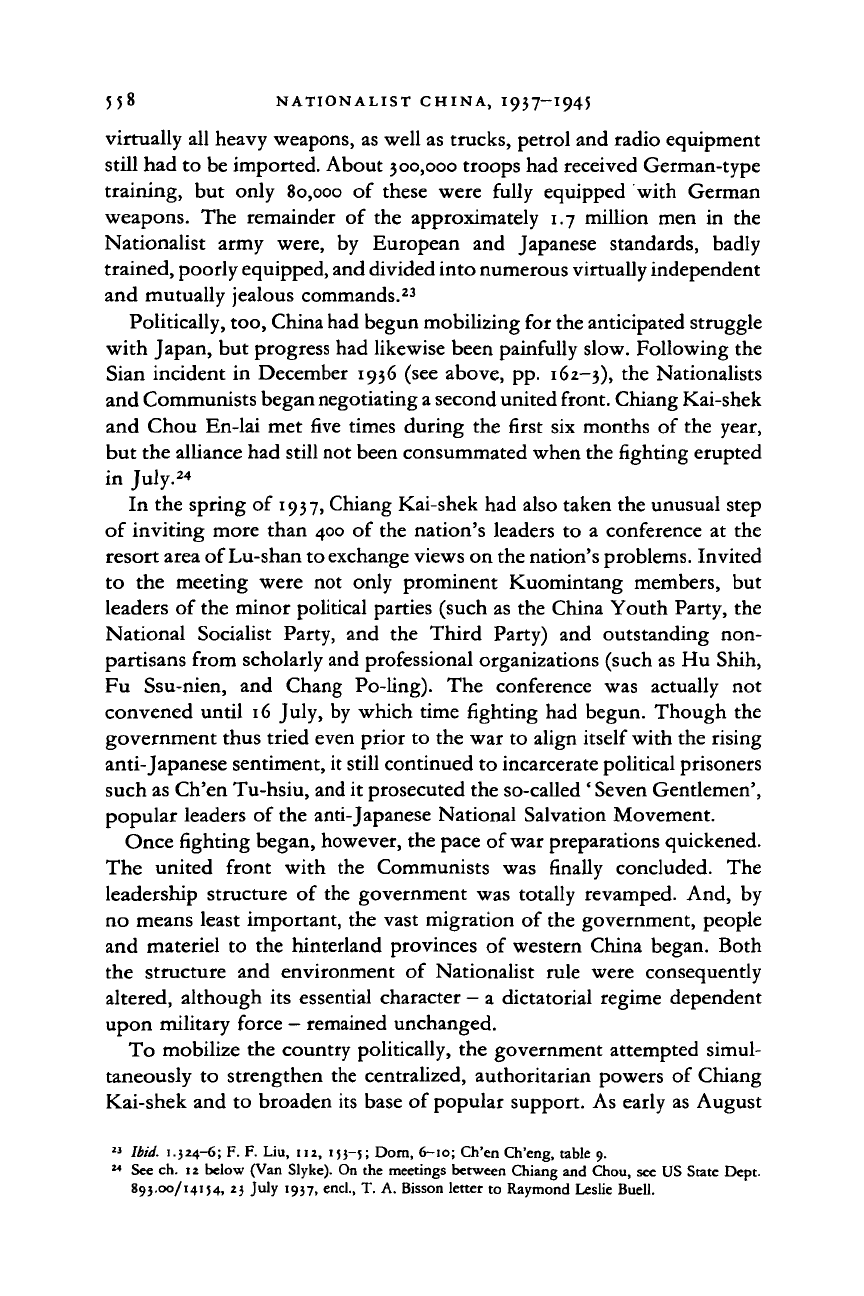
558 NATIONALIST CHINA, I937-I945
virtually all heavy weapons, as well as trucks, petrol and radio equipment
still had to be imported. About 300,000 troops had received German-type
training,
but
only 80,000
of
these were fully equipped with German
weapons. The remainder
of
the approximately
1.7
million men
in the
Nationalist army were,
by
European
and
Japanese standards, badly
trained, poorly equipped, and divided into numerous virtually independent
and mutually jealous commands.
23
Politically, too, China had begun mobilizing for the anticipated struggle
with Japan, but progress had likewise been painfully slow. Following the
Sian incident in December 1936 (see above, pp. 162-3), the Nationalists
and Communists began negotiating
a
second united front. Chiang Kai-shek
and Chou En-lai met five times during the first six months of the year,
but the alliance had still not been consummated when the fighting erupted
in July.
24
In the spring
of
1937, Chiang Kai-shek had also taken the unusual step
of inviting more than 400
of
the nation's leaders
to a
conference
at
the
resort area of Lu-shan to exchange views on the nation's problems. Invited
to
the
meeting were
not
only prominent Kuomintang members,
but
leaders of the minor political parties (such as the China Youth Party, the
National Socialist Party,
and the
Third Party)
and
outstanding non-
partisans from scholarly and professional organizations (such as Hu Shih,
Fu Ssu-nien,
and
Chang Po-ling).
The
conference
was
actually
not
convened until 16 July, by which time fighting had begun. Though the
government thus tried even prior to the war to align itself with the rising
anti-Japanese sentiment, it still continued to incarcerate political prisoners
such as Ch'en Tu-hsiu, and it prosecuted the so-called
'
Seven Gentlemen',
popular leaders of the anti-Japanese National Salvation Movement.
Once fighting began, however, the pace of war preparations quickened.
The united front with
the
Communists
was
finally concluded.
The
leadership structure
of
the government was totally revamped. And,
by
no means least important, the vast migration of the government, people
and materiel
to
the hinterland provinces
of
western China began. Both
the structure
and
environment
of
Nationalist rule were consequently
altered, although its essential character
-
a dictatorial regime dependent
upon military force
-
remained unchanged.
To mobilize the country politically, the government attempted simul-
taneously
to
strengthen the centralized, authoritarian powers
of
Chiang
Kai-shek and to broaden its base of popular support. As early as August
23
Ibid.
1.324-6;
F. F. Liu, 112, 153-5; Dora, 6-10; Ch'en Ch'eng, table 9.
M
See ch. 12 below (Van Slyke). On the meetings between Chiang and Chou, see US State Dept.
893.00/14154, 23 July 1937, end., T. A. Bisson letter to Raymond Leslie Buell.
Cambridge Histories Online © Cambridge University Press, 2008
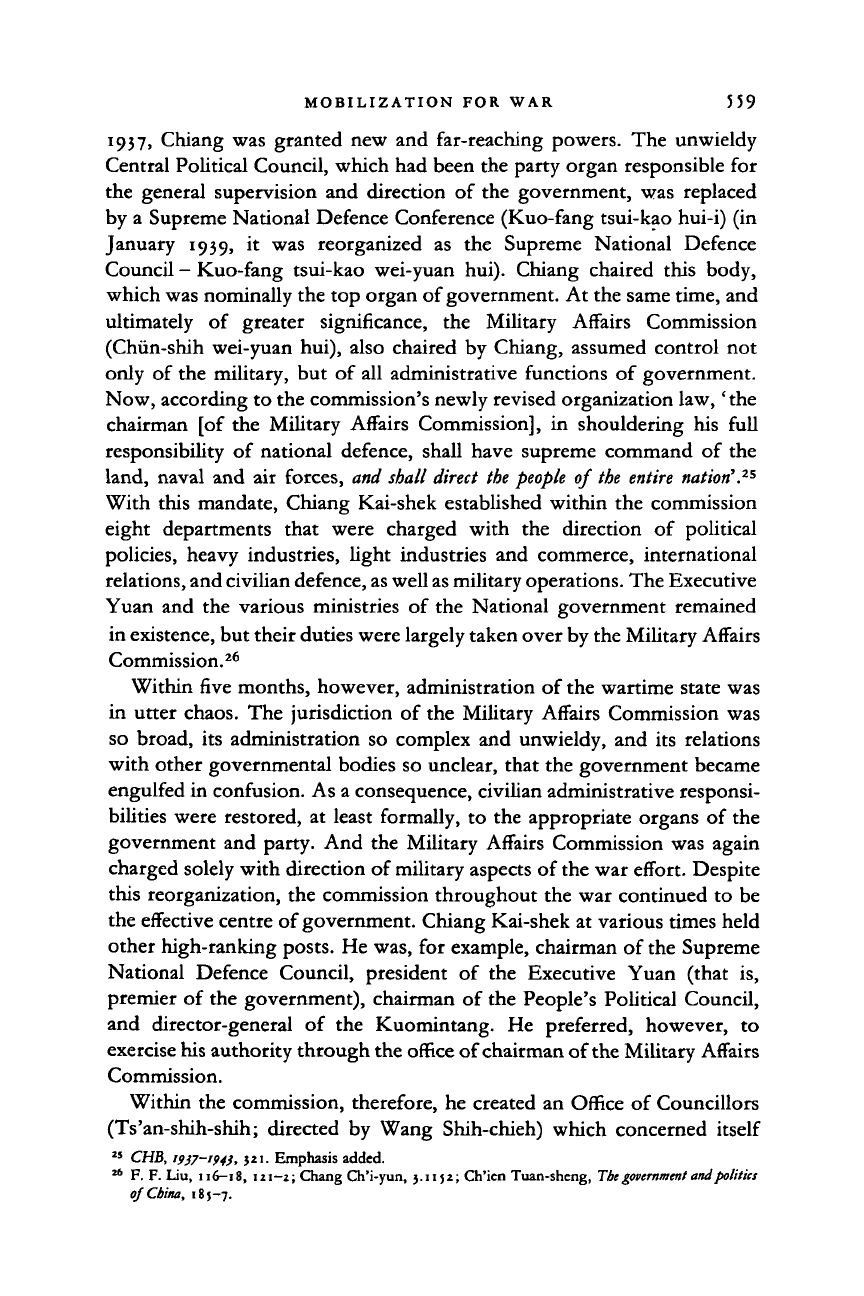
MOBILIZATION FOR WAR 559
I
937> Chiang was granted new and far-reaching powers. The unwieldy
Central Political Council, which had been the party organ responsible for
the general supervision and direction of the government, was replaced
by a Supreme National Defence Conference (Kuo-fang tsui-kao hui-i) (in
January 1939, it was reorganized as the Supreme National Defence
Council - Kuo-fang tsui-kao wei-yuan hui). Chiang chaired this body,
which was nominally the top organ of government. At the same time, and
ultimately of greater significance, the Military Affairs Commission
(Chun-shih wei-yuan hui), also chaired by Chiang, assumed control not
only of the military, but of all administrative functions of government.
Now, according to the commission's newly revised organization law,' the
chairman [of the Military Affairs Commission], in shouldering his full
responsibility of national defence, shall have supreme command of the
land, naval and air forces, and shall direct the people of the entire nation'.
25
With this mandate, Chiang Kai-shek established within the commission
eight departments that were charged with the direction of political
policies, heavy industries, light industries and commerce, international
relations, and civilian defence, as well
as
military
operations.
The Executive
Yuan and the various ministries of the National government remained
in existence, but their duties were largely taken over by the Military Affairs
Commission.
26
Within five months, however, administration of the wartime state was
in utter chaos. The jurisdiction of the Military Affairs Commission was
so broad, its administration so complex and unwieldy, and its relations
with other governmental bodies so unclear, that the government became
engulfed in confusion. As a consequence, civilian administrative responsi-
bilities were restored, at least formally, to the appropriate organs of the
government and party. And the Military Affairs Commission was again
charged solely with direction of military aspects of the war effort. Despite
this reorganization, the commission throughout the war continued to be
the effective centre of government. Chiang Kai-shek at various times held
other high-ranking posts. He was, for example, chairman of the Supreme
National Defence Council, president of the Executive Yuan (that is,
premier of the government), chairman of the People's Political Council,
and director-general of the Kuomintang. He preferred, however, to
exercise his authority through the office of chairman of the Military Affairs
Commission.
Within the commission, therefore, he created an Office of Councillors
(Ts'an-shih-shih; directed by Wang Shih-chieh) which concerned itself
25
CHB,
1937-194), 521. Emphasis added.
26
F. F.
Liu, 116-18, 121—2; Chang Ch'i-yun, 5.1152; Ch'ien Tuan-sheng, Tie government and politics
of
China,
185-7.
Cambridge Histories Online © Cambridge University Press, 2008
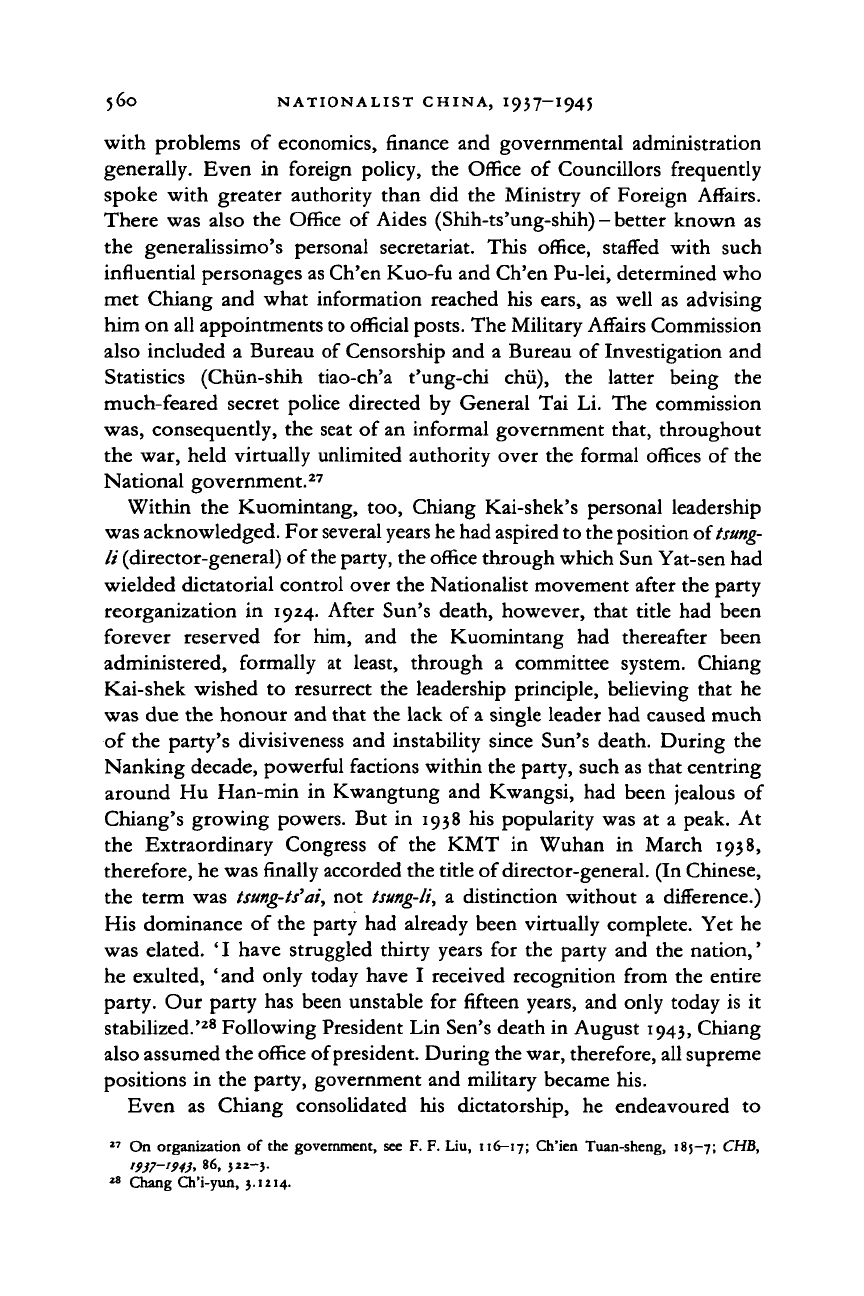
560 NATIONALIST CHINA, I937-I945
with problems
of
economics, finance and governmental administration
generally. Even
in
foreign policy, the Office
of
Councillors frequently
spoke with greater authority than did the Ministry
of
Foreign Affairs.
There was also the Office
of
Aides (Shih-ts'ung-shih)
-
better known
as
the generalissimo's personal secretariat. This office, staffed with such
influential personages as Ch'en Kuo-fu and Ch'en Pu-lei, determined who
met Chiang and what information reached his ears,
as
well as advising
him on all appointments to official posts. The Military Affairs Commission
also included
a
Bureau of Censorship and
a
Bureau of Investigation and
Statistics (Chiin-shih tiao-ch'a t'ung-chi chii),
the
latter being
the
much-feared secret police directed by General Tai Li. The commission
was,
consequently, the seat of an informal government that, throughout
the war, held virtually unlimited authority over the formal offices of the
National government.
27
Within the Kuomintang, too, Chiang Kai-shek's personal leadership
was acknowledged. For several years he had aspired to the position
oitsung-
li (director-general) of the party, the office through which Sun Yat-sen had
wielded dictatorial control over the Nationalist movement after the party
reorganization
in
1924. After Sun's death, however, that title had been
forever reserved
for
him,
and the
Kuomintang
had
thereafter been
administered, formally
at
least, through
a
committee system. Chiang
Kai-shek wished
to
resurrect the leadership principle, believing that
he
was due the honour and that the lack of a single leader had caused much
of the party's divisiveness and instability since Sun's death. During the
Nanking decade, powerful factions within the party, such as that centring
around
Hu
Han-min
in
Kwangtung and Kwangsi, had been jealous
of
Chiang's growing powers. But
in
1938 his popularity was
at a
peak.
At
the Extraordinary Congress
of the
KMT
in
Wuhan
in
March 1938,
therefore, he was finally accorded the title of director-general. (In Chinese,
the term was
tsung-ts'ai,
not
tsung-li,
a.
distinction without
a
difference.)
His dominance of the party had already been virtually complete. Yet he
was elated.
'I
have struggled thirty years
for
the party and the nation,'
he exulted, 'and only today have
I
received recognition from the entire
party. Our party has been unstable for fifteen years, and only today is
it
stabilized.'
28
Following President Lin Sen's death in August 1943, Chiang
also assumed the office of president. During the war, therefore, all supreme
positions in the party, government and military became his.
Even
as
Chiang consolidated
his
dictatorship,
he
endeavoured
to
17
On organization
of
the government, see F. F. Liu, 116-17; Ch'ien Tuan-sheng, 185—7; CUB,
>9J7-'94).
86,
522-}.
28
Chang Ch'i-yun, j.1214.
Cambridge Histories Online © Cambridge University Press, 2008
